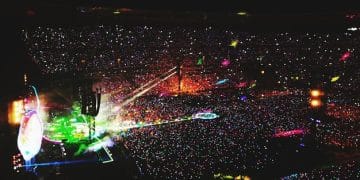J-Pop Idol Music Video Budgets: Reaching US Audiences – Costs & Strategies

J-Pop idol music video budgets vary significantly, reflecting production quality, artist popularity, and target audience, with some groups investing heavily to reach and resonate with US audiences through elaborate visuals and high-production values.
The world of J-Pop is known for its catchy tunes and visually stunning music videos. But how much do these videos actually cost, especially when bands are trying to capture the attention of US audiences? Let’s dive into J-Pop idol music video budgets and the strategies behind them.
Understanding J-Pop Music Video Production Costs
J-Pop music videos are renowned for their high production values, intricate choreography, and visually appealing aesthetics. But before these videos hit the screens, a lot goes on behind the scenes. Understanding the costs involved in producing a J-Pop music video involves breaking down the key components that contribute to the overall budget.
Key Components of Music Video Budgets
The budget for a music video can be influenced by various factors, from the scale of production to the talent involved. Here are some typical elements:
- Pre-Production: This involves concept development, storyboarding, location scouting, and securing permits.
- Production: This encompasses the actual filming process, including camera equipment rental, set design, lighting, and the crew’s wages.
- Post-Production: This includes editing, visual effects, color correction, and audio mixing.
- Talent Costs: Fees for the idol group members, dancers, actors, and any other performers involved.

Additional costs may include marketing and promotion expenses, especially if there’s a focus on reaching specific regions or demographics. Moreover, artist popularity also affects the budget, as more established groups can command higher investment levels from their labels.
Typical Budget Ranges for J-Pop Music Videos
So, how much does it really cost to produce a J-Pop music video? The answer varies greatly based on the production’s ambitions, the artist’s profile, and the target audience.
Generally, a lower-budget J-Pop music video can range from $50,000 to $100,000. This might cover basic production elements, such as simple sets, standard camera work, and minimal visual effects. These types of videos often focus on performance-based content and utilize straightforward narratives. Mid-range productions might spend around $100,000 to $300,000, enabling the utilization of better locations, a larger crew, and more sophisticated post-production work.
High-end productions can easily surpass $300,000, and in some cases, reach up to $1 million or more. These videos feature elaborate sets, top-tier equipment, and extensive visual effects, akin to short films. They often incorporate complex storylines, high-profile directors, and are designed for maximum impact. Such investments reflect the importance of music videos in promoting J-Pop culture on a global stage.
Budget numbers are flexible, and resources can be shifted around to emphasize elements that align with the marketing strategy.
Strategies for Reaching US Audiences
When targeting US audiences, J-Pop groups often employ various strategies to maximize their impact and achieve recognition. These strategies span different aspects of music video production and marketing.
- Enhanced Visuals and Production Quality: US audiences are accustomed to high-quality visuals, so investing in top-notch video production becomes essential, enabling visual storytelling beyond the standard J-Pop concept.
- Subtle Cultural Adaptations: Making minor modifications to themes and narratives can help songs resonate better in the US while maintaining their unique identity.
- Strategic Collaboration: Working with US-based directors, choreographers, or even cameo appearances from US celebrities can generate interest and exposure.
Careful planning and cultural sensitivity are significant when aiming to capture the attention of US viewers.
Case Studies: Budget Allocation in Successful J-Pop Music Videos
To get a clearer picture of how budgets are spent, examining successful J-Pop music videos that have resonated with US audiences can be highly informative. These case studies highlight specific investment areas and the resulting impact.

Example Scenarios of Budget Allocation
Let’s explore hypothetical scenarios where J-Pop groups successfully allocate their music video budgets to capture US audience attention:
- Collaborative Music Video: Involving collaboration with a US artist and featuring scenes shot in both Japan and the US, this video might allocate a significant portion of its budget to international logistics, artist fees, and promotional events.
- High-Concept Music Video: Incorporating a storyline that addresses universal themes or references US pop culture. A substantial amount goes toward set design, visual effects, and post-production.
- Viral Dance Video: Centered around a catchy dance routine, this music video would emphasize choreography, lighting, and camera work to create a compelling dance spectacle.
By strategically allocating resources, J-Pop groups can create videos that appeal to a broad audience while maintaining their unique identity. The careful management of expenditure is pivotal in maximizing reach and impact, leading to greater recognition in the US market.
Future Trends in J-Pop Music Video Investments
As technology and audience expectations evolve, the future of J-Pop music video investments is likely to undergo significant changes. Staying ahead of these trends will be crucial for J-Pop groups aiming to capture US audiences.
- Virtual Production Technologies: The adoption of virtual sets and real-time visual effects will reduce production expenses while enabling increased creativity.
- Interactive and Immersive Experiences: Incorporating elements such as 360° views, augmented reality (AR), and virtual reality (VR) could provide engaging viewing experiences.
- Data-Driven Customization: Using data analytics to optimize video content, tailoring it to appeal directly to specific demographic groups within the US market.
By exploring innovative technologies and data-driven strategies, J-Pop artists can adapt their approaches and create music videos that appeal to US audiences more effectively.
Measuring Success: Metrics for US Audience Engagement
When J-Pop groups invest in music videos targeting US audiences, it’s essential to have metrics to measure the success of these investments. Tracking the right data points can provide insights into what resonates with viewers and where improvements can be made.
Several key performance indicators (KPIs) should be monitored. View counts, watch time, and engagement rates (likes, shares, and comments) on platforms like YouTube are standard measures. However, it’s important to go beyond these basic metrics:
Deeper Audience Engagement Metrics
Analyzing audience demographics and geographic data can reveal whether the music video is reaching the intended US audience. Additionally, tracking social media mentions, fan-generated content, and media coverage in the US can provide insights into broader cultural impact. These metrics help assess the return on investment and guide future strategies.
- Social Media Buzz: Monitoring hashtags, mentions, and shares can reveal how well the songs and artists are being received on platforms like Twitter, Instagram, and TikTok.
- Fan Participation: User-generated content, such as dance covers, reaction videos, and fan art, can indicate deeper engagement and cultural resonance.
- Media Coverage: Tracking articles, reviews, and interviews in US-based media outlets demonstrates broader industry recognition and influence.
| Key Element | Brief Description |
|---|---|
| 💰 Budget Allocation | Strategic investment in visuals, talent, and promotion. |
| 🎯 Target Audience | Tailoring content to resonate with US viewers while preserving J-Pop essence. |
| 📈 Success Metrics | Tracking views, engagement, and media coverage to measure impact. |
| ✨ Future Trends | Adopting virtual production and immersive technologies. |
Frequently Asked Questions
▼
J-Pop music video budgets can range from modest to extravagant, similar to those in the US, but often prioritize elaborate visuals and synchronized dance routines.
▼
Social media platforms like YouTube, TikTok, and Twitter are crucial for sharing J-Pop music videos, engaging with fans, and making content go viral in the US.
▼
Challenges include overcoming cultural barriers, competing with mainstream US music, and ensuring content resonates with diverse American viewers.
▼
Collaborations can enhance visibility and credibility, introducing J-Pop to new fans while bridging cultural gaps, leading to greater acceptance and popularity.
▼
Successful J-Pop videos in the US often combine high-quality production, unique visuals, catchy songs, and a genuine connection with what interests American audiences.
Conclusion
Understanding J-Pop idol music video budgets and the associated strategies is essential for J-Pop groups aiming to capture US audiences. By strategically allocating resources, maintaining cultural authenticity, and embracing innovative technologies, these artists can create compelling content that resonates with a global audience.





